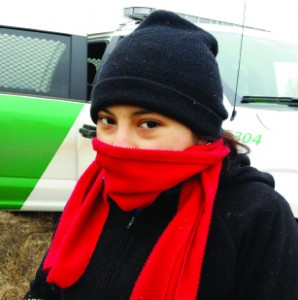By Gilda Morales
This New Year’s Eve night, a group of 14 people who were aban- doned in Valentine by their “coyote”, visited local homes asking for food and water. US Customs and Border Protection patrol agents apprehended the group the next morning in a vacant house where they were left stranded when another coyote failed to meet them and guide them to their nal destination. They had been walking for a week and were cold and hungry. Agents attempts to isolate the group led to a loud ten minute struggle with one male who escaped out the back of the dwelling running North. Lisa Morton of The Advocate was able to interview and photograph the group including an 18 year-old girl from Ecuador, whose hope was to join her mother and grandmother in New York.
The frightened young girl was asked what motivated her to flee her country and travel such a long distance to parts unknown, especially in the dead of night and in bitterly cold conditions. The girl answered that conditions were incredibly deplorable and dangerous in her country, where “bandidos”, (bandits), caused her and her family to live in fear. These “bandidos” routinely kidnap and hold family members for ransom.
Other members of the group, primarily from Ecuador, Guatemala, other regions of Central America and Chihuahua, Mexico, stated that their U.S. destinations were as far north as Ohio and New York. According to agents, many illegal border crossers are abandoned by their “coyotes”, who are only one of the many contacts immigrants make to secure a new life in America. More often, they call the Border Patrol themselves to be rescued after days of grueling travel by foot.

Recently, an article in the New York Times revealed that “coyotes”, (coyetaje), often attempt to reassure frightened clients by telling them that if they turn themselves in to Border Patrol, they will be treated more favorably and could even be allowed to stay. Often, the migrants are guided to the border and instructed to run toward Border Patrol agents as a way to obtain better treatment.
The article explained that a recent increase in gang violence has been behind the recent influx of migrants from Central America, and the consensus of most detainees is that the conditions encountered on their journeys are still far better than those in their own countries. These conditions are ripe for a burgeoning coyote business that is incredibly organized and sophisticated.
This business is not a new one, with the rst record of this type of activity occurring around 1882. At that time, there was a labor shortage that produced a huge demand for workers from Mexico due to legislation called the Chinese Exclusion Act. The demand for workers was so great that illegal crossing was largely accepted and unregulated, with the government turning a blind eye.
Currently, the coyote business is run very ef ciently with a highly organized structure. The “vaquetones,” or recruiters, make up the rst layer of the business and are sent out to solicit and encourage gullible people to migrate. When enough clients are recruited, they are transported, usually by bus, to designated motels on the border, waiting for word from the organization to cross. The vaquetones are quite tech-savvy, and are knowledgeable about Border patrol schedules and routines.
The “chequadores” are the of – cial eyes of the organization, whose job it is to check for the right time to cross, and who often are out tted with state of the art equipment such as night-vision goggles and two-way radios. The “cuidanderos” or caretakers have the responsibility of distracting agents to allow for crossers to make their getaway, and it is not unusual for the cuidanderos to be American high school students who know that the penalty for getting caught is less severe because they are minors.
Usually, after a successful border crossing, the immigrants are taken to the nearest large city to a “safe house” often owned by businessmen funding the crossings. In this particular case, the immigrants were abandoned and were left to fend for themselves without food, water and in bone-chilling temperatures dropping to the low 30’s.
The highest ranking members of the organization are the patrones, who are in charge of the nancial aspects of a very lucrative business that extracts fees ranging from $1500 to $2,500 per person, with estimates that the coyotaje business grosses in excess of $5 billion dollars per year. With more extensive patrolling of the border, coyotes are becoming more aggressive and encouraging travel in outrageous conditions such as the brutal heat of summer and bitter cold of winter, ultimately resulting in more deaths.
However, the look in the eyes of the thin, frail 18-year-old girl as she was being led away, unmasked an uncertainty of her hopes of being reunited with her mother and grandmother in a country full of promise and back to an unpredictably perilous existence.









